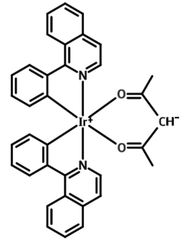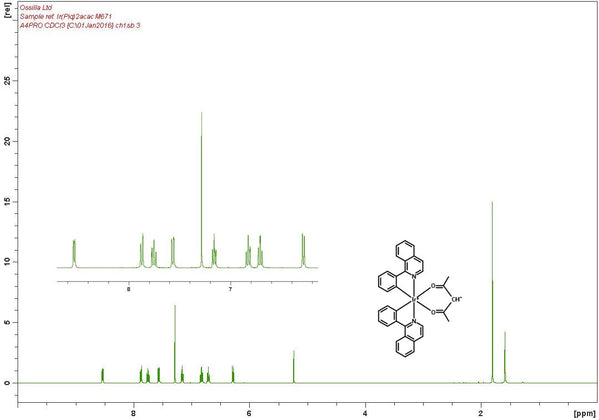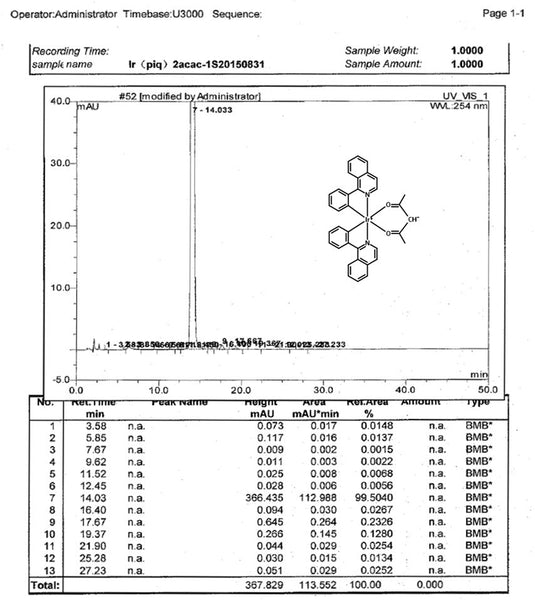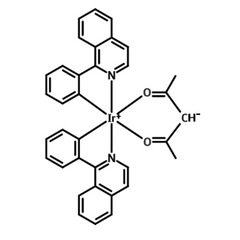Ir(piq)2(acac)
CAS Number 435294-03-4
Dopant Materials, High Purity Sublimed Materials, Semiconducting Molecules
Ir(piq)2(acac), efficient phosphorescent red emitter dopant material in PhOLED devices
High-purity (>99.0%) and available online for priority dispatch
Bis(1-phenylisoquinoline)(acetylacetonate)iridium(III), Ir(piq)2(acac), is widely used as an efficient phosphorescent red emitter dopant material in PhOLED devices. It was reported that the piq ligand can partially suppress the triplet-triplet annihilation and show short phosphorescent lifetime [2].
General Information
| CAS number | 435294-03-4 |
|---|---|
| Chemical formula | C35H27IrN2O2 |
| Molecular weight | 699.82 g/mol |
| Absorption | λmax 302 nm in THF |
| Phosphorescence | λem 633 nm in THF |
| HOMO/LUMO | HOMO = 5.0 eV, LUMO = 3.0 eV [1] |
| Synonyms |
|
| Classification / Family | Organometallic complex, Phosphorescent red emitter, Red dopant, OLED and PLED materials, Sublimed materials |
Product Details
| Purity |
>99.5% (sublimed) >99.0% (unsublimed) |
|---|---|
| Melting point | 366-370 °C (lit.) |
| Appearance | Red powder/crystals |
*Sublimation is a technique used to obtain ultra pure-grade chemicals. For more details about sublimation, please refer to the Sublimed Materials.
Chemical Structure

Device Structure(s)
| Device structure | ITO/m-MTDATA (30 nm)/NPB (20 nm)/TPBI:4 wt% Ir(ppy)3:2 wt% Ir(piq)2(acac) (30 nm)/ Alq3(20 nm)/LiF/Al [3] |
|---|---|
| Colour | White |
| Max. Luminance | 33,012 cd/m2 |
| Current Efficiency@100 cd/m2 | 15.3 cd/A |
| Max. Powder Efficiency | 10.7 lm W−1 |
| Device structure | ITO/DNTPD* (60 nm)/NPB (20 nm)/mCP (10 nm)/mCP:FIrpic (25 nm)/CBP:Ir(piq)2acac (5 nm)/BCP (5 nm)/Alq3 (20 nm)/LiF (1 nm)/Al (200 nm) [4] |
|---|---|
| Colour | White |
| EQE@500 cd/m2 | 8.2 % |
| Current Efficiency@500 cd/m2 | 12.7 lm W−1 |
| Device structure | ITO/NPB (20 nm)/TCTA (10 nm)/BIQS*:(piq)2Ir(acac) ( 4 wt%, 30 nm)/BCP (15 nm)/Alq3 (50 nm)/LiF (1 nm)/Al (100 nm) [6] |
|---|---|
| Colour | Red |
| Max. Luminance | 60,138 cd/m2 |
| Max. EQE | 23.7 |
| Max. Current Efficiency | 28.6 cd/A |
| Max. Power Efficiency | 24.2 lm W−1 |
| Device structure | ITO/NPB/anthracene/TPBI:11% Irppy3:0.5% Ir(piq)2(acac)/Mg:Ag [7] |
|---|---|
| Colour | White |
| Max. Luminance | 6,398 cd/m2 |
| Max. Current Efficiency | 6.4 cd/A |
| Device structure | ITO/MoO3(1nm)/CBP(20nm)/CBP:Ir(piq)2(acac) (3 wt.%,4 nm)/CBP: Ir(DMP)3(5 wt.%,4 nm)/CBP:Ir(ppy)2(acac)(7 wt.%,5 nm)/CBP(3 nm)/Bepp2:BCzVBi(50wt.%,40nm)/Bepp2(20nm)/LiF(1nm)/Al(100nm) [8] |
|---|---|
| Colour | White |
| Max. Current Efficiency | 26.4 cd/A |
| Max. Power Efficiency | 24.8 lm W−1 |
| Device structure | ITO/NPB/CBP:3 wt%TBPe:1 wt%rubrene/Zn(BTZ)2:5 wt% Ir(piq)2(acac)/Zn(BTZ)2/Mg:Ag [9] |
|---|---|
| Colour | White |
| Max. EQE | 2.4% |
| Max. Luminance | 23,000 cd/m2 |
*For chemical structure information please refer to the cited references.
Characterisation


Pricing
| Grade | Order Code | Quantity | Price |
|---|---|---|---|
| Unsublimed (>99.0% purity) | M672 | 250 mg | £260 |
| Unsublimed (>99.0% purity) | M672 | 500 mg | £460 |
| Unsublimed (>99.0% purity) | M672 | 1 g | £800 |
| Sublimed (>99.5% purity) | M671 | 250 mg | £480 |
| Sublimed (>99.5% purity) | M671 | 500 mg | £900 |
| Sublimed (>99.5% purity) | M671 | 1 g | £1450 |
MSDS Documentation
Literature and Reviews
-
Multilayer organic electrophosphorescent white light-emitting diodes without exciton-blocking layer,
G. Lei et al., Appl. Phys. Lett. 88, 103508 (2006); http://dx.doi.org/10.1063/1.2185255. - Yellow and Red Electrophosphors Based on Linkage Isomers of Phenylisoquinolinyliridium Complexes: Distinct Differences in Photophysical and Electroluminescence Properties, C-L. Li et al., Adv. Funct. Mater. 15, 387-395 (2005); DOI: 10.1002/adfm.200305100.
- High-efficiency electrophosphorescent white organic light-emitting devices with a double-doped emissive layer, W. Xie et al., Semicond. Sci. Technol. 20, 326–329 (2005); doi:10.1088/0268-1242/20/3/013.

 Ir(piq)2(acac) MSDS sheet
Ir(piq)2(acac) MSDS sheet